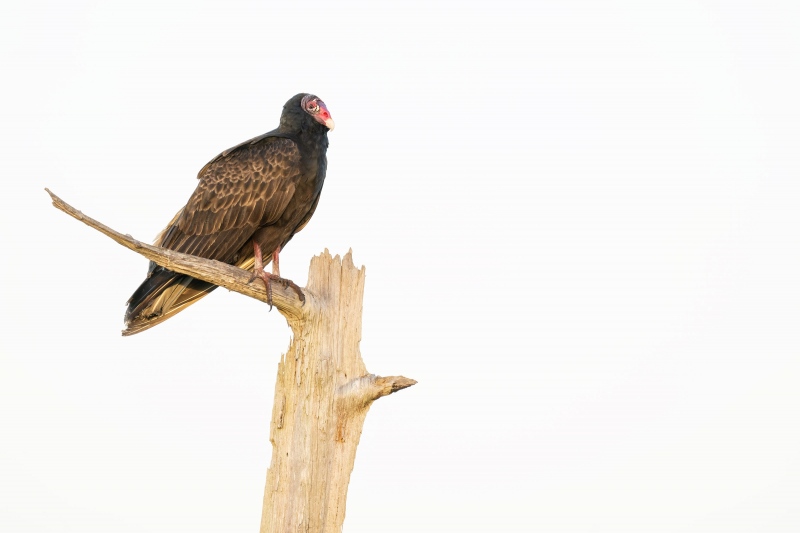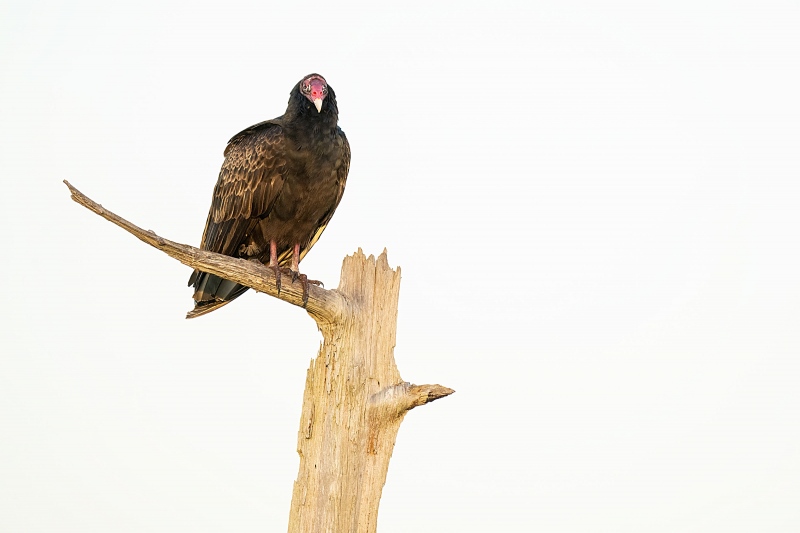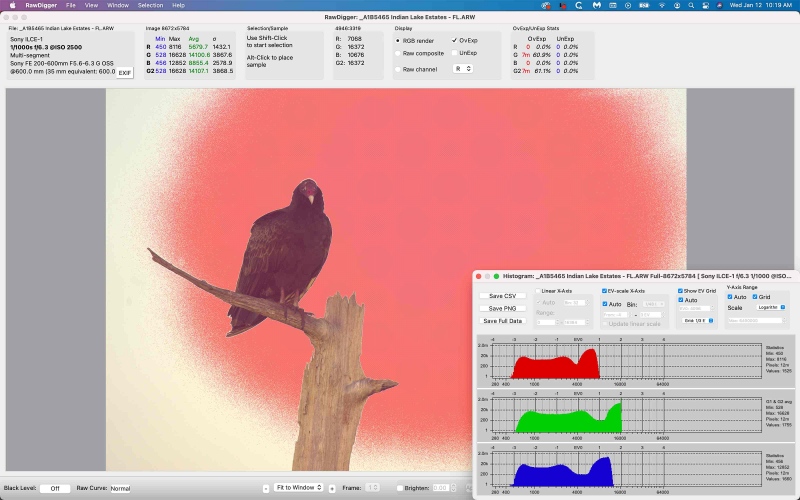What’s Up?
Wednesday morning was close to a bust photographically. I did see another pair of cranes copulating and I spotted a Purple Gallinule in the marsh just to the north of the pier after my less-than-inspiring blur session. It was cloudy most of the day, but the sun broke through just after 5:00pm so I headed down to the lake as there was a nice wind from the east. But there were lots of clouds. Thinking that my chances were somewhere between Slim and None, I brought the laptop so that I could work on this blog post. And did. Unfortunately, None was the victor — the sun ducked behind a cloud and then quickly disappeared for good.
Today is Thursday 13 January 2022, packing day. I leave for San Diego early on Friday. The forecast for the morning is for solidly cloudy with a breeze from the northeast. I will likely head down to the pier for some blurs and then check on the eagle nest. Then I need to get to work packing. Wherever you are, and whatever you are doing, I hope that you too have a great day. This blog post took about an hour to prepare and makes 64 consecutive days with a new one.
|
|
|
This image was created on 11 January 2022 at Indian Lake Estates. Standing outside of my SUV, I used the hand held Sony FE 200-600mm f/5.6-6.3 G OSS lens (at 600mm), and The One, the Sony Alpha 1 Mirrorless digital camera. ) ISO 1250. Exposure determined via Zebras with ISO on the rear dial: 1/400 sec. at f/6.3 (wide open) in Manual mode. AWB at 7:45:06am on a barely sunny morning. Click on the image to enjoy a high-res version. Image #1: Turkey Vulture on The Perch II, facing to the right
|
A Strange Morning
Monday had been a strange morning. It was cold with a brisk wind from the northwest. I walked out onto the pier with the big lens in one hand and the tripod in the other. There were dozens of Turkey Vultures on the pier railing. I had set up without a TC and the a1 was set up for blurs. So when the vultures took off and some of them landed on the railing a bit farther out on the pier, I made a few images. One of those turned out to be pretty cool. You will see it here at some point; it is entitled No Room at the Inn. I got to my favorite morning blur spot halfway out on the pier and saw a load of Cattle Egrets in the relatively distant marsh. As nothing was taking flight and I was freezing, I went back to the car and grabbed my bright yellow Emperor Penguin expedition parka. Again the vultures were on the railing with lots more on both sides of the pier. As it did not look as if any birds would be leaving the roost anytime soon I grabbed the 200-600 with my second a1 and set up for blurs. I went upwind of the vultures in hopes of making some pleasing blurs. I tried but that was about it.
Then the sun came over the big cloud in the east. There had been a vulture on The Perch, so I doubled back and was surprised to see that it was still there. I was glad that it did not fly off at my careful approach. I made some images and left the bird where I had found it. With my RawDigger education, I can always get the exposures very close to perfect especially with subjects that I know well. None-the-less, I am always experimenting to see if I can determine the difference between perfect and dead-solid perfect exposures in the field. With RawDigger you are constantly learning.
It is nice to see that after six months of inactivity, several species of birds have been using The Perch fairly regularly for the past few weeks.
|
|
|
This image was created on 11 January 2022 at Indian Lake Estates. Standing outside of my SUV, I used the hand held Sony FE 200-600mm f/5.6-6.3 G OSS lens (at 600mm), and The One, the Sony Alpha 1 Mirrorless digital camera. ) ISO 2500. Exposure determined via Zebras with ISO on the rear dial: 1/1000 sec. at f/6.3 (wide open) in Manual mode. AWB at 7:45:42am on a barely sunny morning. Click on the image to enjoy a high-res version. Image #2: Turkey Vulture on The Perch II, facing the camera
|
Your Call
Which is the stronger image? Which pose do you like best? Why? Which is the more elegant photograph?
|
|
Image #2A: RawDigger screen capture for the Turkey Vulture on The Perch II, facing the camera image |
White Sky/Dark Subject
In white sky/dark subject situations, you must over-expose the sky to come up with a good exposure for the dark subject. I did just that here to the tune of 7,000,000 Ov-Exp pixels. I could have actually gone a bit lighter. Note the beautiful detail on the vulture’s black breast.
RawDigger — not for the faint of heart …
Nothing has ever helped me learn to create perfect exposures to the degree that RawDigger has. I think that many folks are reluctant to learn that most of their images are underexposed by one or more full stops and that highlight warnings in Photoshop, Lightroom, Capture One, and your in-camera histogram are completely bogus as they are based on the embedded JPEGs. Only your raw files tell the truth all the time. Heck, I resisted RawDigger for several years … Once you get over that feeling, RawDigger can become your very best exposure friend no matter what system you are using. On the recent IPTs and In-the-Field sessions, we have demonstrated that fact. Convincingly.
The RawDigger (pink) Adapted Histogram
In the RawDigger e-Guide, you will learn exactly how to set up the Adapted “pink” RawDigger Histogram and how to use it to quickly and easily evaluate the exposure or raw file brightness of images from all digital cameras currently in use. RawDigger was especially helpful to me when I struggled with R5 exposures and when learned my new camera body, the Sony Alpha a1.
|
|
RawDigger e-Guide with Two Videos |
The RawDigger e-Guide with Two Videos
by Arthur Morris with Patrick Sparkman
The RawDigger e-Guide was created only for serious photographers who wish to get the absolute most out of their raw files.
Patrick and I began work on the guide in July 2020. At first we struggled. We asked questions. We learned about Max-G values. We could not figure out why the Max G values varied by camera system. IPT veteran Bart Deamer asked lots of questions that we could not answer. We got help from RawDigger creator Iliah Borg. We learned. In December, Patrick came up with an Adapted Histogram that allows us to evaluate the exposures and raw file brightness for all images created with all digital camera bodies from the last two decades. What we learned each time prompted three complete beginning to end re-writes.
The point of the guide is to teach you to truly expose to the mega-Expose-to-the-Right so that you will minimize noise, maximize image quality, best utilize your camera’s dynamic range, and attain the highest possible level of shadow detail in your RAW files in every situation. In addition, your properly exposed RAW files will contain more tonal information and feature the smoothest possible transitions between tones. And your optimized images will feature rich, accurate color.
We teach you why the GREEN channel is almost always the first to over-expose. We save you money by advising you which version of RawDigger you need. We teach you how to interpret the Max G values for your Canon, Nikon, and SONY camera bodies. It is very likely that the Shock-your-World section will shock you. And lastly — thanks to the technical and practical brilliance of Patrick Sparkman — we teach you a simple way to quickly and easily evaluate your exposures and raw file brightness using an Adapted RawDigger histogram.
The flower video takes you through a session where artie edits a folder of images in Capture One while checking the exposures and Max-G values in RawDigger. The Adapted Histogram video examines a series of recent images with the pink histograms and covers lots of fine points including and especially how to deal with specular highlights. The directions for setting up the Adapted Histogram are in the text.
If we priced this guide based on how much effort we put into it, it would sell it for $999.00. But as this guide will be purchased only by a limited number of serious photographers, we have priced it at $51.00. You can order yours here in the BAA Online Store.
Typos
With all blog posts, feel free to e-mail or to leave a comment regarding any typos or errors.


















Image #2 is my favorite. Have a safe and great trip to San Diego. One of my all time favorite locations to visit.
Well, Artie, this is the first time I have seen “elegant” and “turkey vulture” in the same sentence! . I prefer image 2. I think it’s better balanced. Safe travels to San Diego.
Agree, and I thought of that. But it works for me.
with love, artie
I definitely prefer #2–the eye contact just draws the viewer into the image.
Down the lens barrel often works well 🙂 Thanks for leaving a comment.
with love, artie
In image #1, the white tip of the beak blends a little too much into the sky. Image #2, where you can clearly define the full shape of the beak makes it a stronger image. Also, Image #2, with the angle of the head and body reminds me of those old drawing of English noblemen.
Thanks, Jay. I agree, Image #2 is somewhat Victorian …
with love, artie
Both lovely shots. The texture of the trunk is exquisite. I prefer number one.
Thanks, Margaret. I agree on exquisite. In ABP II, I wrote something like this: “Look for perches with character.”
with love, artie
I prefer Image #2 as I like seeing both eyes.
Thank you kind proofreader 🙂
with love, artie
ps: or is it proof-reader?
#2 for the obvious reason…looking right at the camera.
There’s something else though that intrigues me. Even though
the crop is the same as #1 and the perch hasn’t moved, the vulture
feels closer because of the head angle.
Doug
Hey Doug,
Thanks. Image #2 is cropped slightly tighter …
with love, artie